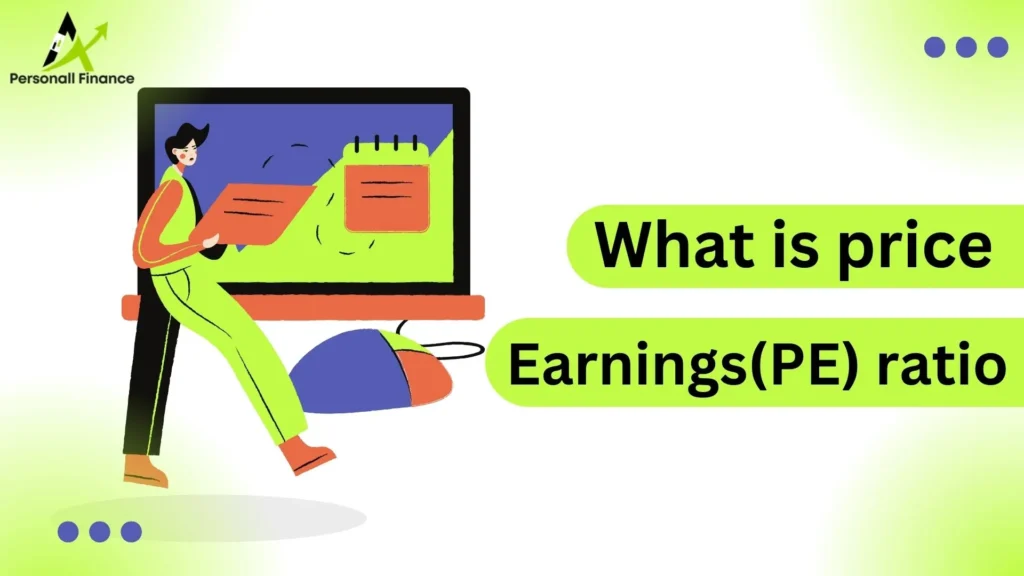Introduction
Investors face a daunting task when choosing which stocks to add to their portfolios. The stock market related issues demands careful analysis, and one of the essential tools at an investor’s use is the Price-to-Earnings (PE) ratio. This financial metric gives priceless insight into a company’s financial health and market sentiment.

Table of Contents
ToggleMeaning of price-to-earnings ratio
At its core, the Price-to-Earnings ratio, or PE ratio, serves as an indicator to analyze a stock’s valuation. This important metric measures the relationship between a company’s stock price and its earnings per share (EPS). By doing so, it helps investors find whether a stock is overvalued, undervalued, or fairly priced.
Types of PE Ratio
1. Trailing PE Ratio:
This version of the ratio is calculated using a company’s historical earnings. It reflects how much investors are ready to pay for past earnings. In short, it provides an insight into a company’s track record.
2. Forward PE Ratio:
In contrast, the forward Price–earnings ratio is based on estimated future earnings. Investors use this approach to gain insights into how the market values a company’s expected performance. It’s a forward-looking metric that considers growth expectations.
How to Calculate the Price–earnings Ratio
The mathematical calculation of the Price–earnings ratio is simple and intuitive.
Stock price / earnings per share is the PE Ratio.
Real-World Example of PE Ratio.
To illustrate the practical application of the PE ratio, let’s consider a hypothetical example involving Company X. This company currently trades at ₹100 per share and reports earnings per share (EPS) of ₹10. The calculation of Company X’s PE ratio would be as follows:
PE Ratio = ₹100 / ₹10 = 10
This result means that investors are ready to pay ten times the company’s earnings for its stock. This information can be compared with other companies’ PE ratios to assess relative valuations.
Why Is the Price–earnings Ratio Important?
The P/E ratio is important because it provides insights into investor sentiment and expectations. A high P/E ratio suggests that investors are willing to pay a premium for a company’s future earnings potential. Conversely, a low P/E ratio may indicate that the stock is undervalued or that investors have lower expectations for future growth.
Interpreting P/E Ratios
- Low P/E Ratios
A low P/E ratio (typically below 20) suggests that the stock may be undervalued. It could indicate that the market has relatively low expectations for the company’s future earnings growth or that there are other concerns about its financial health.
- High P/E Ratios
A high P/E ratio (typically above 25) may indicate that investors have high expectations for the company’s future earnings growth. It could also suggest that the stock is overvalued, as investors are ready to pay a premium for a share of the company’s profits
Benefits of Price–earnings Ratio
The PE ratio offers investors a range of benefits, making it a vital tool in their toolkit:
1. Valuation Comparison: Investors can use PE ratios to compare the valuation of different companies. A lower PE ratio might suggest an undervalued stock, while a higher one could indicate an overvalued stock.
2. Market Sentiment Gauge: The PE ratio also serves as an indicator of market sentiment. A high PE ratio may indicate trust about a company’s growth potential, and a low PE ratio could suggest a more pessimistic outlook.
3. Historical Analysis: By analyzing a company’s historical PE ratios, investors can identify trends and shifts in sentiment over time. This long-term perspective can be invaluable in making investment decisions.
Disadvantages of PE ratio
While the PE ratio is a powerful tool, it’s essential to acknowledge its limitations:
1. Industry Variability: Different industries often exhibit different PE ratios due to their unique characteristics. Comparing the PE ratios of companies in different sectors can be misleading.
2. Earnings Manipulation: Companies can manipulate earnings to improve their PE ratios artificially. This manipulation can lead to a distorted view of a company’s true financial health.
Conclusion
In conclusion, the Price-to-Earnings ratio is a fundamental metric in the world of stock market analysis. It allows investors to estimate a company’s valuation, assess market sentiment, and make informed investment decisions. While recognizing its limitations, investors can leverage the PE ratio as a powerful tool to navigate the complex landscape of the stock market. By understanding every aspect of this metric, investors can better position themselves for success in their investment endeavors.
Frequently asked question
The full form of P/E Ratio is “Price-to-Earnings Ratio.
Yes, the P/E Ratio can vary significantly by industry. Some industries, such as technology or healthcare, often have higher P/E Ratios due to their potential for rapid growth. Conversely, industries like utilities or mature manufacturing may have lower P/E Ratios.
Yes, a company’s P/E Ratio can change over time. Factors such as changes in earnings, market sentiment, and economic conditions can impact the P/E Ratio. Investors should regularly monitor this metric.
Investors can use the P/E Ratio as a part of their investment strategy to identify potential opportunities and risks. It can help assess the relative value of stocks and guide decisions on buying, holding, or selling investments.



